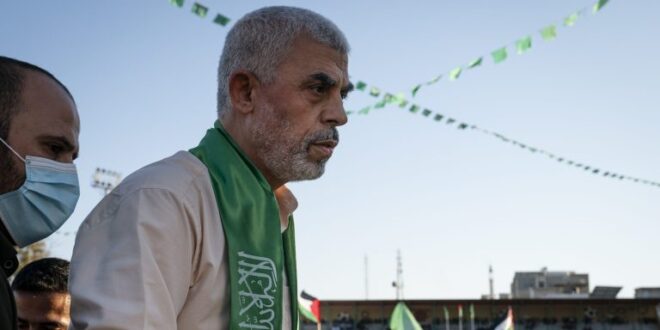- Hamas leader Yahya Sinwar, the mastermind behind the October 7 attacks, was killed in an ambush by the Israeli Defense Forces (IDF) in Rafah.
- The death of Sinwar is a significant win for Israel, however, Prime Minister Binyamin Netanyahu now faces a crucial opportunity to negotiate the release of the hostages, a move that could expedite the conclusion of Israel’s military operations in Gaza.
- It remains unclear whether Hamas will see Sinwar’s death as a loss, potentially paving the way for the release of hostages, or as war sacrifice, which could instead prolong the conflict.
- Regardless of the ongoing war in Gaza, the conflict has now escalated to involve Hezbollah in Lebanon and Iran, potentially complicating efforts to resolve the broader regional crisis.
Israeli Security Forces confirmed yesterday that Yahya Sinwar, leader of Hamas and de-facto ruler of Gaza, was killed in combat on Wednesday during an ambush by the Israeli Defense Forces (IDF) in Rafah. Sinwar’s death marks a significant victory for Israel, especially given his role in orchestrating the brutal October 7 attacks on Israel. It also raises critical questions about the future leadership and direction of Hamas in Gaza and beyond.
Sinwar’s involvement with Hamas dates back to the group’s inception in the late 1980s, when he helped establish a group of fighters that eventually became the Al-Qassam Brigades, Hamas’ military wing. He rose to prominence as the head of Al Majd, Hamas’ internal security unit, tasked with “find[ing] and punish[ing] those suspected of violating Islamic morality laws or cooperating with the Israeli occupiers,” according to the New York Times. In this role, Sinwar killed two Israeli soldiers and several Palestinians whom he accused of collaborating with the IDF, leading to his arrest in 1988 and subsequent 23-year imprisonment until his release in 2011. Following his release, Sinwar’s influence within Hamas quickly grew, becoming the chief of Hamas in Gaza in 2017 and ascending to political chief in August 2024, following the assassination of Ismail Haniyeh in Iran by Israeli forces the previous month.
Sinwar’s central role in orchestrating the October 7 terrorist attacks made him a primary target for Israeli and American intelligence agencies, resulting in multiple assassination attempts. In late January, Israeli and American officials believed they were on the brink of capturing Sinwar when Israeli commandos launched a raid on a tunnel system in southern Gaza where he was suspected of hiding; however, he had vacated the bunker days before the raid. In August, Israeli forces uncovered the bodies of six hostages in a labyrinth of tunnels beneath Rafah in southern Gaza, along with evidence suggesting that Yahya Sinwar had been in the area.
The recent news that Sinwar was killed above ground while reportedly participating in combat against the IDF comes as a surprise, given media sources have consistently reported that he spent most of his time underground in hiding. His death makes him the fourth Hamas top leader assassinated by Israeli forces, following figures like Hamas founder Ahmed Yassin, Hamas co-founder Abdel Aziz al-Rantisi, and former leader Ismail Haniyeh. Khalid Mashael, another key Hamas leader, narrowly survived an Israeli assassination attempt in Jordan in 1997.
Sinwar’s death also disrupts what had seemed to be a deadlock in the potential negotiations with Israel. Considered the most uncompromising of Hamas’ leaders, Sinwar had been a key barrier to any real form of diplomatic engagement. Though not directly involved in talks, Hamas representatives reportedly needed his approval for any concessions and adhered closely to his directives. His red lines in negotiations — some of which were nonstarters for the Israelis – included a complete Israeli withdrawal from Gaza, the release of high-profile Palestinian prisoners, and assurances for the reconstruction of Gaza. According to U.S. intelligence assessments, Sinwar’s stance had hardened in recent weeks, leading American negotiators to believe that Hamas was no longer interested in reaching a ceasefire or hostage agreement. Instead, it appeared that Sinwar sought to escalate the conflict, hoping a larger regional war might pressure Israel into scaling back its operations in Gaza.
As Israelis celebrate the news of Yahya Sinwar’s death, Israeli Prime Minister Binyamin Netanyahu faces a critical and narrow window of opportunity to secure the release of the hostages. Successfully negotiating their return would not only reinforce the military and strategic objectives of weakening Hamas and eliminating key figures like Sinwar, but also serve as a vital step forward to concluding Israel’s war efforts in Gaza. The Israeli government will likely face internal political pressure to reopen negotiations, specifically through intermediaries — the U.S., Qatar, and Egypt — to secure the release of hostages. Any forthcoming negotiations can also serve as a litmus test for Hamas’ operational capacity in the post-Sinwar era. If Hamas continues to demand total withdrawal of the Israeli presence from Gaza and the release of Palestinian prisoners, it may indicate the group’s possible defiance despite leadership losses.
It remains to be seen how Sinwar’s death will impact Hamas operations in Gaza. Despite being significantly weakened after a year of war against the IDF, the military wing of Hamas is heavily decentralized and might continue to operate in the absence of his leadership. It is likely that Sinwar had a contingency plan in place in the event of his death.
However, there is still no clear end in sight for the larger conflict in the region. Regardless of the outcome of the war in Gaza, the conflict has expanded significantly over the last few months, including sparking a new war in Lebanon and escalating tensions with Iran. Israel’s recent strikes in Lebanon have transformed the conflict far beyond its initial focus on Gaza, with Israel looking to dismantle Hezbollah’s internal structure. In September, Israel also stated one of its new war objectives was the safe return of Israeli civilians who had to evacuate from their homes in the north after the October 7 attack due to Hezbollah strikes. Such an objective, particularly of a sustained nature, may prove difficult amid the escalations. Israel has indicated it will reject any ceasefire that may then lead to the reorganization of Hezbollah or the replenishment of its weapons arsenal, indicating that Israel’s operations in Lebanon will not end any time soon.
Additionally, as the northern front of the conflict between Israel and Hezbollah continues to escalate, and both sides continue to exchange fire, Iran may see the assassination of yet another prominent leader in its “Axis of Resistance,” weeks after the assassination of late Hezbollah leader Hassan Nasrallah, as cause for escalation. Iran will likely feel pressure to regain its legitimacy and strength in the eyes of its domestic audience, but also among the proxies it backs throughout the region who have seen their benefactor severely weakened and humiliated in the last months. Simultaneously, Iran must weigh the strategic risk of further provoking Israel, for potentially entangling the United States will harm its long-term interests.
Since the October 7 attack, Israel has repeatedly made clear that it intends to dismantle Hamas’ military capabilities in the Gaza Strip – beyond the elimination of its leader. Ultimately, while Sinwar’s death weakens Hamas, it may also bring political challenges, particularly regarding what is referred to as “the day after” for Gaza and the potential for settlement expansion into northern Gaza that some in the far-right of Israel’s government are calling for. For Hamas, the way it responds to the death of Sinwar will be consequential for the future of the war. It is yet to be seen whether Hamas will regard Sinwar’s death as an irreplaceable loss leading to its defeat or as a war sacrifice, which would likely have little impact on a hostage release or a reduction in fighting –– but may instead embolden the group.
 Eurasia Press & News
Eurasia Press & News



